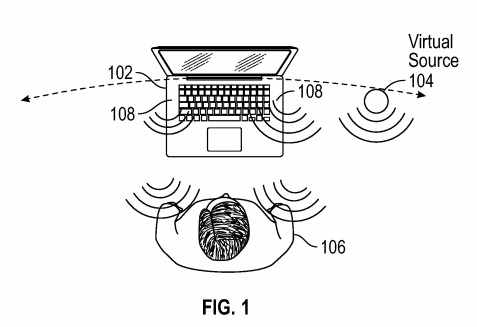Apple patent reveals potential for enhanced virtual surround sound audio

What you need to know
- An Apple patent has revealed technology that could bring enhanced virtual audio to its devices
- It uses crosstalk canceler technology to make audio seem like it's coming from places that it isn't.
- It's said to add to the feeling of "being there" when watching movies, sports or playing videogames.
A new Apple patent published today has revealed technology that could bring enhanced virtual audio to Apple devices.
The patent, published today, is titled "System to move a virtual sound away from a listener using a crosstalk canceler" and the abstract states:
An audio processing system has one or more processors that process an audio signal on three paths. The first path has a direct gain and a direct virtual source algorithm operating on the audio signal. The second path has a plurality of early reflection gains operating on the audio signal. Operation with the early reflection gains produces a plurality of early reflections. Each of the early reflection signals may be subjected to a delay and may be processed according to an early reflection virtual source algorithm. The third path has a reverb gain and binaural reverb filters operating on the audio signal. The third path also has a crosstalk canceler. A mixer combines left and right channel outputs of each of the first path, second path and third path. The mixer produces a left loudspeaker signal and a right loudspeaker signal.
It's essentially a virtual acoustic system that gives the illusion that sound is emanating from places in the room where it isn't, a virtual surround sound system. The description states:
Audio signal processing for virtual acoustics can greatly enhance a movie, a sports even, a videogame or other screen viewing experience, adding to the feeling of "being there". Various known audio processing algorithms, executed by digital processors, modify one or more recorded, synthesized, mixed or otherwise produced digital audio signals in such a way as to position a virtual source according to modeling that is based on human perception of sound, including the role of ear acoustics, other reflecting and absorbing surfaces, distance and angle of source, and other factors. In the case of headphones, specially processed audio signals (binaural rendering) are sent to left and right ears of a listener without the crosstalk that is inevitably received by the ears when listening to stereo loudspeakers. For viewers and listeners that prefer loudspeakers, for example those that may be built into a laptop computer, a crosstalk canceler is employed in some virtual acoustic systems to produce sounds from multiple loudspeakers in such a way that for example a "left" audio signal is predominantly heard only at the left ear of the listener, and a "right" audio signal is predominantly heard only at the right ear of the listener (by virtue of sound wave cancellation in the air surrounding the listener.)
As you may have noted, the patent explains usage for both headphone and speaker users, for example in a MacBook, such that this is a patent for the audio system itself, not a speaker configuration, hence the option to use headphones. The audio processing system splits the audio into three signals, the three signal chains have various effects (reverb, gain) applied to them before being combined into left and right channel outputs that combine all three signals paths.
Some reports on the patent have suggested that this could hint at AR usage in a MacBook or some other such Apple device, however, there is absolutely no mention of either augmented or virtual reality anywhere in the patent. In fact, the drawings accompanying the patents all exclusively show users without any of the accompanying headwear for VR or AR. Rather, it seems that this is simply a way of digitally processing audio in order to enhance the acoustic experience through virtual, digitally generated surround sound.
iMore offers spot-on advice and guidance from our team of experts, with decades of Apple device experience to lean on. Learn more with iMore!

Stephen Warwick has written about Apple for five years at iMore and previously elsewhere. He covers all of iMore's latest breaking news regarding all of Apple's products and services, both hardware and software. Stephen has interviewed industry experts in a range of fields including finance, litigation, security, and more. He also specializes in curating and reviewing audio hardware and has experience beyond journalism in sound engineering, production, and design.
Before becoming a writer Stephen studied Ancient History at University and also worked at Apple for more than two years. Stephen is also a host on the iMore show, a weekly podcast recorded live that discusses the latest in breaking Apple news, as well as featuring fun trivia about all things Apple. Follow him on Twitter @stephenwarwick9
